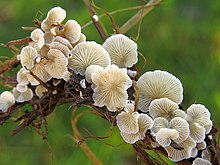Crepidotus epibryus, is a species of saprophytic fungi in the family Crepidotaceae. It is commonly known as grass oysterling in the United Kingdom and is seen there in late summer and autumn.[3]
| Crepidotus epibryus | |
|---|---|

| |
| Crepidotus epibryus | |
| Scientific classification | |
| Domain: | Eukaryota |
| Kingdom: | Fungi |
| Division: | Basidiomycota |
| Class: | Agaricomycetes |
| Order: | Agaricales |
| Family: | Crepidotaceae |
| Genus: | Crepidotus |
| Species: | C. epibryus
|
| Binomial name | |
| Crepidotus epibryus Quél, (1888)[1]
| |
| Synonyms | |
|
Agaricus epibryus Fr., 1821 | |
| Crepidotus epibryus | |
|---|---|
| Gills on hymenium | |
| Cap is convex | |
| Hymenium is free | |
| Lacks a stipe | |
| Spore print is buff | |
| Ecology is saprotrophic | |
| Edibility is inedible | |
Description
edit- Cap: The cap (pileus) of C. epibryus is generally about 0.4 to 1.5 cm in diameter and is convex kidney shaped fanned, coloured white or pale buff with upper tomentose (finely felted) surface.[3]
- Gills: On the underside, the gills (lamellae) are crowded and are classified as free with no stipe to connect to. The colour of the gills depends on maturity ranging from white when young to pinkish brown as the spores mature.[3]
- Spores: The spore print is pale buff. The ellipsoid-shaped basidiospore of C. epibryus are 7-9 by 3-3.5 µm in size.[3]
- Absent features- No stipe (stem) or annulus (ring).
Similar species
edit- Crepidotus variabilis is typically larger, has a smoother cap surface and does not have an inrolled cap margin.
Distribution
editCommon to Britain and Ireland, also occurs in Europe and in North America.
References
editWikimedia Commons has media related to Crepidotus epibryus.
- ^ "Index Fungorum - Names Record". www.indexfungorum.org. Retrieved 2022-05-16.
- ^ "Index Fungorum - Species Record". www.indexfungorum.org. Retrieved 2022-05-16.
- ^ a b c d Kelly, David. "Crepidotus epibryus (Fr.) Quél. - Grass Oysterling". First Nature- Your Wildlife Window on the World Wide Web. First Nature. Retrieved June 17, 2022.